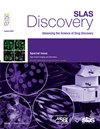Super-resolution microscopy as a drug discovery tool
IF 2.7
4区 生物学
Q2 BIOCHEMICAL RESEARCH METHODS
引用次数: 0
Abstract
At the turn of the century a fundamental resolution barrier in fluorescence microscopy known as the diffraction limit was broken, giving rise to the field of super-resolution microscopy. Subsequent nanoscopic investigation with visible light revolutionised our understanding of how previously unknown molecular features give rise to the emergent behaviour of cells. It transpires that the devil is in these fine molecular details, and essential nanoscale processes were found everywhere researchers chose to look. Now, after nearly two decades, super-resolution microscopy has begun to address previously unmet challenges in the study of human disease and is poised to become a pivotal tool in drug discovery.
超分辨率显微镜作为药物发现工具。
在世纪之交,荧光显微镜中被称为衍射极限的基本分辨率障碍被打破,从而产生了超分辨率显微镜领域。随后的可见光纳米研究彻底改变了我们对以前未知的分子特征如何引起细胞涌现行为的理解。事实证明,关键就在这些细微的分子细节中,研究人员在任何地方都能找到必要的纳米尺度过程。现在,经过近二十年,超分辨率显微镜已经开始解决人类疾病研究中以前未遇到的挑战,并准备成为药物发现的关键工具。
本文章由计算机程序翻译,如有差异,请以英文原文为准。
求助全文
约1分钟内获得全文
求助全文
来源期刊

SLAS Discovery
Chemistry-Analytical Chemistry
CiteScore
7.00
自引率
3.20%
发文量
58
审稿时长
39 days
期刊介绍:
Advancing Life Sciences R&D: SLAS Discovery reports how scientists develop and utilize novel technologies and/or approaches to provide and characterize chemical and biological tools to understand and treat human disease.
SLAS Discovery is a peer-reviewed journal that publishes scientific reports that enable and improve target validation, evaluate current drug discovery technologies, provide novel research tools, and incorporate research approaches that enhance depth of knowledge and drug discovery success.
SLAS Discovery emphasizes scientific and technical advances in target identification/validation (including chemical probes, RNA silencing, gene editing technologies); biomarker discovery; assay development; virtual, medium- or high-throughput screening (biochemical and biological, biophysical, phenotypic, toxicological, ADME); lead generation/optimization; chemical biology; and informatics (data analysis, image analysis, statistics, bio- and chemo-informatics). Review articles on target biology, new paradigms in drug discovery and advances in drug discovery technologies.
SLAS Discovery is of particular interest to those involved in analytical chemistry, applied microbiology, automation, biochemistry, bioengineering, biomedical optics, biotechnology, bioinformatics, cell biology, DNA science and technology, genetics, information technology, medicinal chemistry, molecular biology, natural products chemistry, organic chemistry, pharmacology, spectroscopy, and toxicology.
SLAS Discovery is a member of the Committee on Publication Ethics (COPE) and was published previously (1996-2016) as the Journal of Biomolecular Screening (JBS).
 求助内容:
求助内容: 应助结果提醒方式:
应助结果提醒方式:


